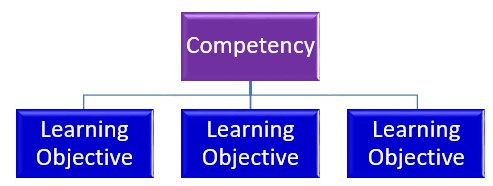Competencies and Learning Objectives
Competencies and learning objectives are often thought to be the same, however, there are significant difference between the two.
Competency: The desired knowledge, skills, and abilities (KSAs) a participant needs to successfully perform specific tasks.
Learning Objective: A very specific statement that describes exactly what a participant will be able to do after completing the course or program.
About Competencies
A competency is an array of essential knowledge, skills, and abilities (KSAs) required to successfully perform a specific task.
- Knowledge is the condition of being aware of something that is acquired through training and/or experience.
- Skill is the ability to physically perform an activity or task. It includes physical movement, coordination, dexterity, and the application of knowledge.
- Ability is the capacity or aptitude to perform physical or mental activities that are associated with a particular task.
Competencies often serve as the basis for standards that specify the level of knowledge and skills required to successfully perform tasks in the workplace. It can be used as a measurement criteria for assessing attainment (e.g. a person has to reach a certain level of competency to be considered successfully completing a task). It can also describe the degree of expertise (e.g. the person is highly competent).
About Learning Objectives
A learning objective is an explicit statement that clearly expresses what the participant will be able to do at the completion of the course or program.
- It is specific
- It is written in behavioral terms
- It contains action verbs that are observable and measurable
- It identifies what behaviors a participant must demonstrate in order to confirm the intended learning occurred
The Difference between Competencies and Learning Objectives
The main distinction between competencies and learning objectives is that competencies are what an individual needs to be able to do in order to successfully perform his or her job functions or tasks. Learning objectives are what the participant will be able to demonstrate during the learning session to confirm they will be able to meet those competencies.
Another distinction is that competencies are often more general than learning objectives. Competencies are bundles of the essential knowledge, skills, and abilities (KSAs) required to achieve an acceptable level of performance, while learning objectives are specific to a course of instruction. A learning objective is a very specific statement that describes exactly what a participant will be able to do in a measurable way after completion of the course. By accomplishing the objectives, the individual develops the necessary competencies.
Connecting Competencies and Learning Objectives
Training courses are designed by working backwards from the desired competencies to the method of instruction. Therefore, the first step is to determine what competencies are needed to perform the necessary tasks. This is done by completing a needs analysis. A needs analysis is a formal and systematic process to determine what an individual needs to be able to do in order to successfully perform tasks at a specific level.
When determining competencies, the goal is to describe the desired abilities needed to perform the task. Desired competencies are then broken down into their basic parts by determining what the participant would need to know to perform this competency at a specific level. Those parts would be the learning objectives. Typically, there is more than one learning objective defined for a given competency.
Once the competencies and learning objectives are defined, learning objectives are mapped to each competency. As noted, each competency can be supported by multiple learning objectives. Learning objectives can be thought of as the steps on the way to attaining a competency.
Examples of Competencies and Learning Objectives
Competency:
- Correctly change the oil on an automobile in less than 10 minutes.
Learning objectives related to the above competency:
By the end of this course, the participant will be able to;
- Locate and remove drain plug
- Determine the appropriate oil weight
- Add the appropriate amount of oil
- Change the filter
Related Links
Learning goals, objectives, and outcome
Learning Goals and Learning Objectives
Components Learning Objectives

